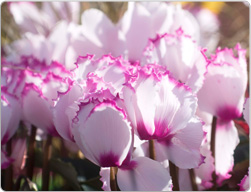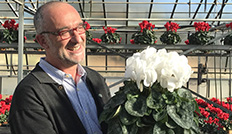 Professional area | Diseases factsheet | Pests | Shore flies (scatella)
Professional area | Diseases factsheet | Pests | Shore flies (scatella)
These small flies are often mistaken for Fungus Gnats, though their body is more squat and their wings are folded one upon the other. They can multiply very rapidly.
Though they feed only on plant debris and scum they are dangerous, in that they can carry certain disease organisms such as Fusarium.
Chemical control is difficult because the individuals are so mobile. It works best on the larval stage.
Young cyclamen in glasshouses are often infested with hundreds of small flies. They fly off very quickly when the leaves are brushed with the hand, but come to rest on another plant not far off.
These little flies belong to the order Diptera, insects characterised by their large compound eyes and single pair of long wings. The Scatella species belong to the Ephydridae family. They do not harm the plat directly themselves, as the Fungus Gnat does (Bradysia, Sciara and Lycoriella genera). The species most often found in glasshouses is Scatella stagnalis.
It is very hard to tell Scatella apart from these others by body features; and this makes it hard to assess the threat to plants.
It is certain, though, that these Shore Flies, though they may not cause direct damage like Bradysia sp., are very efficient carriers of disease-causing organisams such as the Fusarium oxysporum fungus, some special forms of which bring the Fusarium Wilt.
The adult is a dark-coloured fly from 1.5 to 2.2 mm long. The brown/black wings are spotted with little light dots that are easy to see.
The larvae are translucent hairy maggots with false legs (pseudopods). The pupa is a dark brown.
Water is extremely important for Shore Flies. The adults lay on films of water with green algae in, which is what the larvae feed on: puddles on concrete paths or other glasshouse structures. Shore flies and Fungus Gnats can co-exist since they do not occupy the same ecological niche in the glasshouse.
The Shore Fly’s ability to transmit Fusarium oxysporum was demonstrated in 1993 on tomatoes (in the case of Fusarium oxysporum f.sp. lycopersici). The larvae of these Diptera which develop in the neighbourhood of plant roots infected with Fusarium oxysporum can ingest spores from the pathogen. These remain in a semi-active state in the gut of the adult and infect it. As the adult moves around the plants its excreta can contaminate healthy plants.
These excreta also do nothing for the aesthetic value of the cyclamen.
Eradication of the Shore Fly from glasshouses is more or less a pipedream, in view of their numbers and mobility. What needs to be done, then, is to take precautions to prevent the emergence of contaminated plants to act as the source of infection.
Control is aimed against the larval stage by spreading chemicals that are compatible with the plants.
The constant development of the regulations and homologations of phytosanitary treatment products, and the differences in regulations according to each country make it impossible for us to include updated information on homologations. Each producer will have to contact his local plant protection bureau to obtain the latest updates concerning the regulations and use of phytosanitary products. We strongly advise testing beforehand on a plant sample in order to measure the chemical’s activity (establishing the dose) and any effect on the plant (plant poisoning).
With a large broom as wide as the staging it is possible to combat this pest by hand. The broom has a sleeve with a sticky fly-screen, which has lengths of string dangling from it. As the screen is advanced these strings touch the plants and set the flies flying, to get stuck onto the screen.
This advice sheet is based on the methods used at the SCEA at Montourey (Fréjus, France). These procedures may need some modification to adapt them to other climatic situations. Before starting to grow cyclamen there needs to be a review of precautions against pests and diseases. We must point out that our advice and suggestions are offered for information purposes and therefore cannot include any guarantee of specific results; it is a good idea to carry out trials beforehand.

2565, rue de Montourey
83600 Fréjus - France
International telephone : +33 (0)4 94 19 73 04
Switchboard : + 33 (0)4 94 19 73 00
Fax : +33 (0)4 94 19 73 19

